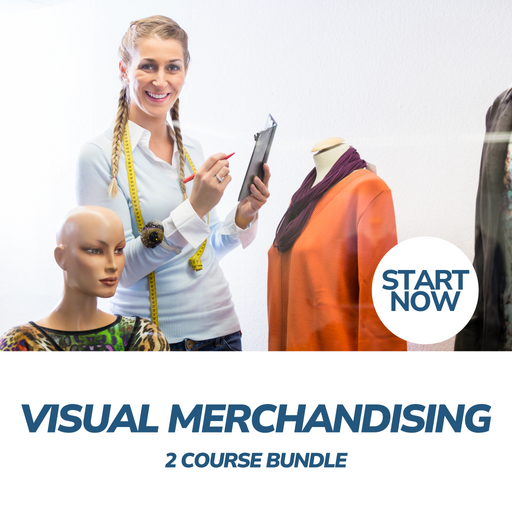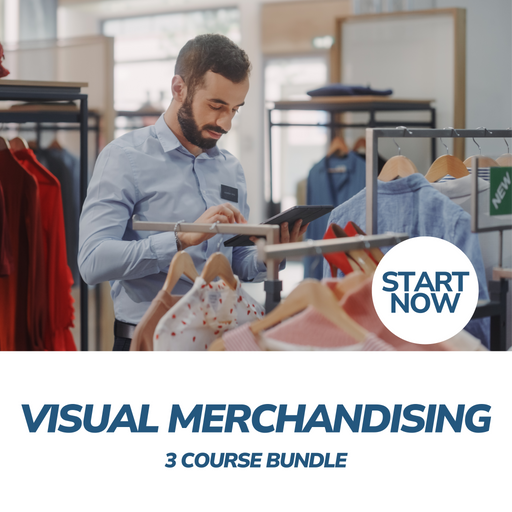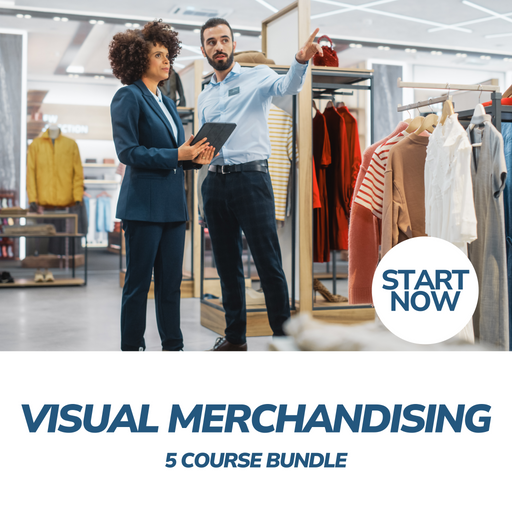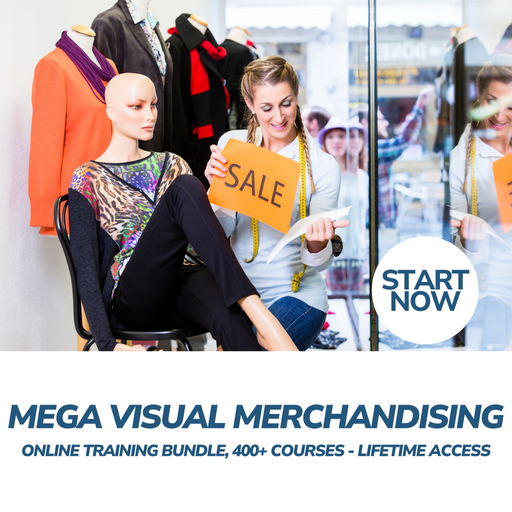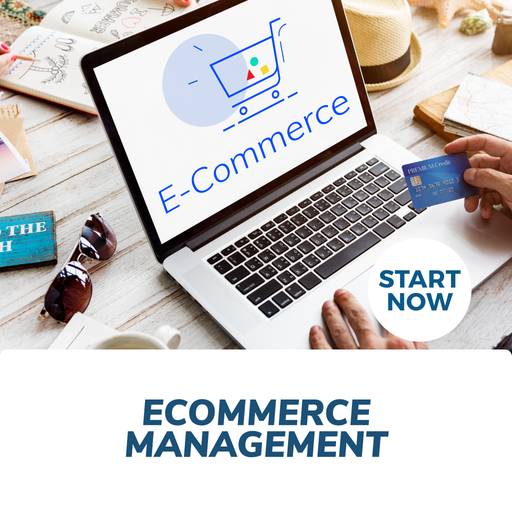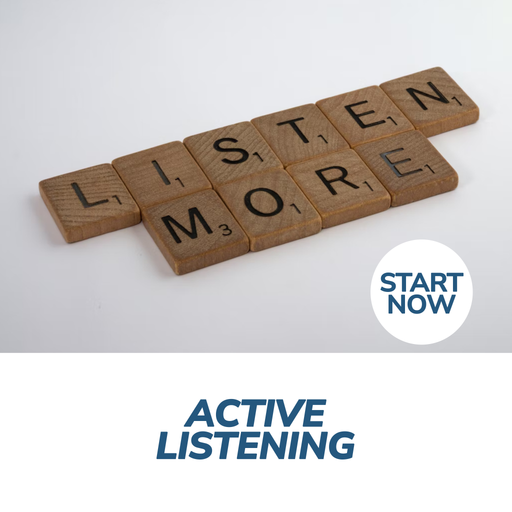
About This Course
What you will learn:
|
|
Study Visual Merchandising course and Learn to Drive Sales and Build Image via Visual Merchandising course
Our Visual Merchandising course offers the opportunity to learn how to use a key retailing strategy effectively. When used effectively, visual merchandising can help drive sales, inspire customer loyalty, improve the customer’s buying experience and communicate brand core values and principles.
This visual merchandising and display program is an ideal introduction to the concepts and practices of this valuable marketing tool.
In this course, you’ll discover the visual merchandising principles that can be applied when working within any type of visual merchandising team. You’ll discover the best way to arrange in-store displays and store design, practical tasks that can help you get some experience, and you’ll learn more about fashion design and fashion marketing.
After completing the online course, you will thoroughly understand what it takes to design and run a fashion merchandising display campaign that has impact and bite.
The beauty of studying for a visual merchandising certificate is that while the content deals primarily with visual sales displays within a retail setting, much of the learning can be applied equally in various other art/design niches.
The knowledge you gain through completing a visual merchandising course online can be applied in other formats like interior design, web design and graphic design for e-commerce sites, exhibition design and even event planning.
What you will learn with our Visual Merchandising diploma course
Know and understand what visual merchandising is and the important role that it has.
Be acquainted with changes in the practices of visual merchandising that have occurred over time.
Know the types of internal and external displays available to use in a campaign
Understand the underlying principles of designs instore and how to create a winning display.
Know how to use planograms as a daily guide.
Know how to use mannequins for maximum sales impact.
Be familiar with fixtures and fittings commonly employed to make an impressive, attention-grabbing visual display.
Appreciate why you need to understand what goes into building an effective store layout
Know how to exhibit home furnishings and associated products to promote sales and improve customer engagement
Appreciate the challenges associated with shoe and accessories displays
Appreciate the key role that visual merchandising plays in successful sales campaigns
Know the key challenges facing merchandisers today and how these challenges shape visual merchandising
Understand how to launch a career in this profession
Identify alternative career paths that visual merchandising experience opens up
Visual Merchandising course - Requirements
The Visual Merchandising course is delivered 100 percent online.
To successfully complete this course, a student must:
Have access to the internet and the necessary technical skills to navigate the online learning resources
Have access to any mobile device with internet connectivity (laptop, desktop, tablet)
Be a self-directed learner
Possess sound language and literacy skills
If you have any concerns about this visual merchandising certificate course, view our frequently asked questions or get in touch with our team to discuss. We can inform you of any entry requirements, tuition fee and provide you with a comprehensive overview of the course details as required.
Quick Course Facts
Course content is structured for easy comprehension
Registered students gain unrestricted access to the Visual Merchandising course
All course material is available online 24/7 and can be accessed using any device
Study online from anywhere in your own time at your own pace
All students who complete the course will be awarded with a certificate of completion
Visual Merchandising Course Description
Module 1: What is Visual Merchandising
Visual merchandising is the art of arranging products within a retail environment in such a way that consumers are encouraged to buy the products.
What are the Aims of Visual Merchandising?
To facilitate the customer’s path around the store
To encourage customers to buy more items
To improve the level of service that customers receive
To create an atmosphere in line with the retailer’s image
To leave a positive impression on the customer
How Visual Merchandising Sells Products
As you may imagine, psychologists have invested considerable time and effort into understanding the factors underpinning individual buying decisions. The following are a few ways in which good visual merchandising can increase the likelihood of a sale.
The Skills and Qualities you Need to Succeed as a Visual Merchandiser
A desire to keep up with the latest fashion trends
The ability to manage other people
The ability to work with design software and drawing equipment
An interest in consumer psychology and human behavior
This module will also discuss:
What does a Visual Merchandiser do on a Day-to-day Basis?
The Differences between Visual, Fashion and Retail Merchandising
Career Paths and Training Options for People Wishing to Work in Visual Merchandising
Module 2: General Principles in Putting Displays Together
In this module, students will learn the basic rules that visual merchandisers follow when putting together a display.
The Main Different Types of Display Used in Retail Environments
Single item display
Variety display
Related items display
Single-line display
Build-up display
Use of Lighting
There are three main types of lighting used in retail displays: primary lighting, store illumination and atmospheric lighting.
Primary lighting
Store illumination
Atmospheric lighting
Use of Color
Color exerts a significant impact on people’s moods, and visual merchandisers take this into account when putting together a display.
Use of Line and Balance within Displays
Vertical
Horizontal
Diagonal
Arcs and Curves
The Importance of Balance in a Display
Most of us are not familiar with the intricacies of design theory, but we can usually tell whether a collection of objects looks ‘right’.
Contrast, Proportion and Repetition
Creating a dissonance between two elements is almost guaranteed to attract the attention of someone walking past a display.
Telling a Story within a Display
The best displays convey a sense of story and narrative.
Module 3: Mannequins
Mannequins fall into the uncanny realm – the fine line between human and non-human. People react strongly to mannequins, particularly those on the more realistic end of the spectrum.
The Various Types of Mannequins Available
Realistic mannequins
Semi-realistic mannequins
Abstract mannequins
Semi-abstract mannequins
Headless mannequins
Mannequin Positions – Standing, Sitting, Horizontal and Vertical
Retailers have come to appreciate that mannequins placed in more natural poses can encourage customers to imagine how a piece of clothing may look on a real human body, as opposed to a piece of plastic that roughly approximates the shape of a generic person.
How to Care for Mannequins
A high-quality mannequin is a sound investment. But in order to keep them looking good and keep them structurally sound, they must be cared for by trained staff who understand their structure and function.
How to Dress Mannequins
Some mannequins are molded so that they cannot be taken apart and must be dressed in the same manner as a rigid doll.
Alternatives to Mannequins
Whilst mannequins are a key staple for many retailers, they are not always the most appropriate choice for a display.
Display techniques
Lay-down
Pin-up
Flying
Module 4: Stands and Other Store Fixtures Used in Visual Merchandising
A fixture is a piece of furniture or an accessory that is designed to hold, store and display products.
Arranging Fixtures and Fittings – Front-to-Back Display
Whatever type of fixtures a visual merchandiser chooses to use, the principle of the front-to-back display will normally dictate how they are to be placed on the shop floor.
The Most Common Types of Stands Used in Retail Environments
Garment racks
Panels
Pegboard
Gondolas
Étagères
Cube units
Tables
Signs
Signs are used to guide customers around the store and alert them to special offers or promotions.
Topics in this module include:
How Easy is it to Install Various Types of Fixtures?
How to Choose the Best Type of Fixture for an Attractive Display?
The Dominance Factor
Using the Back Wall
Module 5: Planning Store Layouts
Store planning is the art of mapping out how the walls, doors, windows, ceilings, floors, fixtures and fittings within a store can be optimized, to improve the shopper’s experience and encourage them to spend more money.
What are the Differences between Store Planning and Visual Merchandising?
A store planner will usually have a background in architecture, interior design or both. They need to possess a good understanding of how buildings are constructed and must be able to produce accurate blueprints and diagrams that use standard architectural conventions.
Why Should a Visual Merchandiser Take an Interest in Store Planning?
It allows them to troubleshoot weak spots
It allows them to understand any upcoming changes
It may lead to new career opportunities
Why is Store Planning so Important?
The experience of entering and navigating a store will determine a customer’s overall impression of the retailer.
The Most Common Types of Store Layout
Grid floor plan/Straight
Grid floor plan/Diagonal
Loop floor plans
Free flow floor plans
What Tools are Used to Draw up a Store Plan?
Until the advent of widespread computer-based technology, designers and architects would have to rely solely on their technical drawing skills, when producing blueprints. Over the past few decades, computer applications have become ever more sophisticated and play a key role in the design process.
Module 6: Displaying Home Accessories, Homeware and Food
This course has primarily focused on visual merchandising in relation to fashion and personal accessories. This is because most merchandisers are particularly interested in these areas, with many people entering the retail industry as a result of their interest in fashion.
The Difference between ‘Homeware’ and ‘Home Accessories’
Homeware is the term given to furniture, utensils and ornaments sold for use in the home.
Key Points to Bear in Mind When Displaying Homeware and Home Accessories
Natural settings are useful in communicating how products ‘come together’. Shoppers like to be able to imagine what a product will look like in their own home, and they like to know how various home accessories will look when positioned in close proximity.
Displaying Fabrics and Common Fabric-based Items
Rolls of fabric
Bed linen
Towels
Module 7: Merchandising Shoes and Fashion Accessories
Visual merchandising is perhaps most often discussed in the context of clothing displays, but it is a vital factor in the successful retailing of shoes and fashion accessories.
How to Merchandise Shoes
An effective shoe display highlights the range available within a store while underlining the functionality specific to one particular kind of shoe.
What Props and Tools are Used When Displaying Shoes?
Stuffing
Tags
Gridwall or slatwall panels and shelves
How to Merchandise Jewelry
Jewelry can either be shown in the context of an overall look, displayed alongside other pieces or highlighted as a single product.
How to Display Hats
Although many styles of hats are designed with function in mind, they may also be perceived as festive or even frivolous accessories.
How to Merchandise Bags
Shoppers do not ‘wear’ bags in the strict sense of the word. Nevertheless, they tend to regard them as extensions of their outfits.
How to Display Scarves and Gloves
As with shoes and handbags, customers want to know what a scarf looks like when worn and how it can be combined with other garments and accessories to create a stylish look.
Module 8: Creating Effective Sales and Clearance Campaigns
An in-store or window display is usually put together to draw a shopper’s attention to one or more products available.
Using Graphics and Signage to Promote a Sale
Signs are the primary means by which a retailer communicates to customers that they are holding a sale.
Arranging Marked-down Products in a Shop Window
When arranging window displays during a sale, the key rule is never to include specific products marked down for sale.
Using Symbolism to Engage
Shoppers During Sales Symbolism, within the context of themed displays, is highly effective in enticing a shopper to enter the store and look at the discounted lines.
Arranging Marked-down Products Inside a Store
How products are arranged inside a store varies depending on the retailer’s image, the size of the sale, the target demographic and the value of the stock.
Maintaining a Consistent Brand Image
Most stores hold sales or clearance campaigns when they need to shift stock to make way for new lines.
Maintaining an Attractive Sales Display
Products that have been put on sale are more likely than others to be handled by customers.
Module 9: Issues in 21st Century Visual Merchandising
Changes in Modern Retail
Retailers have always been forced to compete with others selling similar products and have always had to consider how they can best accommodate the latest trends.
How do Retailers Keep up with Developments within the Industry?
Trade journals
Conference
Sales data
Consumer surveys and panels
The Rise of Online Commerce
The most significant change confronting modern retailers is the increasing role of online shopping in the retail landscape.
Will Real-life Stores become Obsolete?
Over the years, there has been much speculation about the fate of real-life stores.
Online shopping
Real-life retailers
Module 10: Starting and Furthering Your Career as a Visual Merchandiser
Summary/What you will Learn
Why you need to take a proactive approach to advance within the retail industry;
What you need to consider before studying a formal qualification, and how to choose the right course for you;
The options available to you with regards to working hours and environments;
How to keep up with changing trends in the retail industry;
The typical career paths open to visual merchandisers;
Why you should consider joining the British Display Society, to boost your career prospects.
From entry-level store positions to senior management roles, working in the retail sector offers you the opportunity to make a difference in peoples’ lives at a day-to-day level.
Further Information and Learning
The beauty of studying with CFS is that you can study abroad as an international student and still receive the same qualification as every other student. The graduate outcomes are the same no matter where you are located.
For course students who have an interest in continuing professional development, CFS also provides a variety of other courses. Student enrolment is easy and our online learning system is easy to understand. On completion of courses, you’ll have lifetime access to the materials provided. Get in touch to request information or simply browse through the courses online.
Recognition & Accreditation
Upon successfully completing this course and achieving a passing score for the assessment, you will be issued an international continuing education credit (CEU) certificate.
This Certificate is applicable worldwide, demonstrating your commitment to learning new skills. You can share the certificate with your friends, relatives, co-workers, and potential employers. Also, include it in your resume/CV, professional social media profiles and job applications.
Units of Study
Module 1: What Is Visual Merchandising?
- What is meant by the term ‘visual merchandising’;
- The key aims of visual merchandising as a retail practice;
- The history of visual merchandising;
- Why visual merchandising is important and effective in selling products;
Module 2: General Principles in Putting Displays Together
- Why key design principles are the foundation of every successful display;
- The most common types of display used in retail environments;
- How to use lighting, to make merchandise more appealing to the customer;
- How colour can be employed, to display products to good effect;
Module 3: Mannequins
- The advantages of using mannequins, to display clothing and accessories;
- How to care for and store mannequins;
- How to dress a mannequin;
- The various forms available that can replace or supplement mannequins;
Module 4: Stands and Other Store Fixtures Used in Visual Merchandising
- What is meant by the term ‘fixture’, in the context of the retail industry;
- The relationship between the fixtures used in visual merchandising and the way in which a product or line of products is displayed;
- The various types of stands used in retail environments and how they can enhance a display;
- How to use platforms and elevations, to show off store merchandise;
Module 5: Planning Store Layouts
- What is meant by the term ‘store planning’;
- How the role of a store planner differs from that of a visual merchandiser;
- Why visual merchandisers should take the time to become familiar with the purposes of store planning, and how it is carried out in practice;
- The key purposes and aims of store design;
Module 6: Displaying Home Accessories, Homeware and Food
- The types of merchandise that fall under the category of home accessories (also known as ‘home fashions’;
- The importance of setting the scene and using lifestyle themes, when displaying homeware and home accessories;
- How to display small and fragile goods in a safe, aesthetically pleasing manner;
- How to use mannequins in the promotion of homeware;
Module 7: Merchandising Shoes and Fashion Accessories
- Why the presentation of shoes, jewellery and fashion accessories is just as important as that of clothes;
- The most common props used by visual merchandisers, in order to display items in these categories;
- How to present shoes, in order to form an attractive display;
- How to display jewellery in a way that catches the eye of the customer;
Module 8: Creating Effective Sales and Clearance Campaigns
- How visual merchandising plays an essential role in the performance of a sales campaign;
- How to use signs, to promote a sale, and the most effective words and phrases to use, in encouraging sales;
- How to use symbolism, to communicate price reductions;
- How to use mannequins and other props, to draw attention to a sale;
Module 9: Issues in 21st Century Visual Merchandising
- Why retail does not stand still, and how retailers can stay abreast of the latest trends;
- The rise of online shopping and its implications for visual merchandising;
- Why omnichannel retailing is growing in popularity and the implications of this trend, for those working in visual merchandising;
- The role of pop-up shops in contemporary retail and how a visual merchandiser can put together effective displays, in these environments;
Module 10: Starting and Furthering Your Career as a Visual Merchandiser
- Why you need to take a proactive approach, in order to advance within the retail industry;
- What you need to consider, before studying a formal qualification, and how to choose the right course for you;
- The options available to you with regards to working hours and environments;
- How to keep up with changing trends in the retail industry;
Requirements
Entry requirements
Students must have basic literacy and numeracy skills.
Minimum education
Open entry. Previous schooling and academic achievements are not required for entry into this course.
Computer requirements
Students will need access to a computer and the internet.
Minimum specifications for the computer are:
Windows:
Microsoft Windows XP, or laterModern and up to date Browser (Internet Explorer 8 or later, Firefox, Chrome, Safari)
MAC/iOS
OSX/iOS 6 or laterModern and up to date Browser (Firefox, Chrome, Safari)
All systems
Internet bandwidth of 1Mb or fasterFlash player or a browser with HTML5 video capabilities(Currently Internet Explorer 9, Firefox, Chrome, Safari)
Students will also need access the following applications:
Adobe Acrobat Reader
Requirements
Entry requirements:
Students must have basic literacy and numeracy skills.
Minimum education:
Open entry. Previous schooling and academic achievements are not required for entry into this course.
Device requirements:
Students will need access to a computer/any device and the internet.
FAQS
1. Who are Courses For Success?
Courses For Success is a course platform that started in 2008
with 5 courses, since then we have grown to over 10,000 online courses.
Our courses span across the following categories:
•Animal
•Beauty
•Business
•Health & Fitness
•Finance
•Lifestyle
•IT & Software
•Personal Development
•Teaching & Academics
2. Is there a refund/cancellation policy?
Yes, we have a 7-day money-back refund guarantee. Just send us an email to info@coursesforsuccess.com with the subject Courses For Success Refund so we can accommodate your request.
3. What is the FREE Personal Success Training Program?
The Personal Success Training Program
was developed by Courses For Success to help our customers achieve
success. Currently, we are offering this program for FREE with every
course or bundle purchase this month. This is a limited time offer!
4. Are there any requirements to study this course?
No,
anyone who has an interest in learning more about this subject matter
is encouraged to take our course. There are no entry requirements to
take this course.
5. Do I require to have finished high school to complete this course?
No,
you do not require a High School Diploma or to have finished school to
study this course, this course is open to anyone who would like to take
this course.
6. What if English is not my first language?
This
course is provided in English, however, due to the digital nature of
our training, you can take your time studying the material and make use
of tools such as google translate and Grammarly.
7. Is this course online or conducted in person?
All our courses are accessible online on any device. You may complete them at your own pace and at your own time.
8. How do I receive my course?
After
you have completed the payment, you will receive a confirmation email
and tax receipt. You will also receive an email containing your course
login details (username and password), as well as instructions on how to
access and log in to your course via the internet with any device,
please check your junk/spam folder in the event that you do not receive
the email.
9. When does this course start?
Providing
you have internet access you can start this course whenever you like,
just go to the login page and insert your username and password and you
can access the online material.
10. What is online learning like?
Online learning is easy, if not easier than a traditional academic situation.
By studying an online course, the usual boundaries caused by location and time constraints are eliminated, meaning you are free to study where and when you want at your own pace.
Of course, you will need to be able to self-manage your time and be organized, but with our help, you’ll soon find yourself settling into a comfortable rhythm of study.
11. What computer skills do I need for my course?
You
don't need to be a computer expert to succeed with our online training,
but you should be comfortable typing, using the internet and be capable
of using common software (such as Microsoft word).
12. How long will you have access to the online course?
The majority of our courses have unlimited lifetime access, meaning you can access this course whenever you want.
Please also check the course summary, as a small selection of courses have limited access.
13. How long will my course take?
Course duration, is listed under Course Summary
14. Do I need to buy textbooks?
All the required material for your course is included in the online system, you do not need to buy anything else.
15. Is the course interactive?
Yes, all our courses are interactive.
16. Is there an assessment or exam?
Yes,
you will be required to complete a multiple-choice test online at the
end of your course, you can do this test as many times as you require.
17. What type of certificate will I receive?
You
will receive a Certificate of Completion that is applicable worldwide,
which demonstrates your commitment to learning new skills. You can share
the certificate with your friends, relatives, co-workers and employers.
Also, include it in your resume/CV, professional social media profiles
and job applications.
Wendy Sue Hunt - 5 STAR REVIEW
"If you are considering taking any “Courses for Success”, I would highly recommend it. I have always been a firm believer it’s important to always sharpen your skills. You are never too old to learn more. I found the courses very helpful, interesting and easy to understand.
The term “Courses for Success” helped me in my current position to succeed. After completing the courses, I gave my manager the completion certificates. Recently I received a promotion too."
Valencia Marie Aviles - 5 STAR REVIEW
"I
had a very good experience with my course. It has helped me to get
multiple jobs and prepared me for almost everything I would need to
know. The course was very informative and easy to understand and broken
up perfectly to be done in a short amount of time while still learning a
good amount! I would recommend Courses for Success to anyone trying to
get abs certifications for job advancements, it is well worth it!"
ELENA GRIFFIN - 5 STAR REVIEW
"I have absolutely enjoyed the materials from Courses for Success. The materials are easy to understand which makes learning enjoyable. Courses for Success have great topics of interest which make you come back for
more.
Thank you Courses for Success for being part of my learning journey and making education affordable!"
Our
completion certificates are very valuable and will help you progress in
your work environment and show employers how committed you are to learn
new skills, you might even get a promotion.
18. Will this course be credited by universities?
No, it is not equivalent to a college or university credit.
19. Am I guaranteed to get a job with this certificate?
This course will give you the skills you need to help you obtain employment, but it’s up to you if you get the job or not.
20. How will this course assist me with my career?
Studying
and completing this course will show employers that you have the
knowledge in this field, additionally you will gain more confidence in
this area of expertise.
21. How long is the certificate valid for?
The Certificates are valid for life and do not need renewing.
22. Can I take more than one course at a time?
Courses
are studied online at your own pace and you are free to study as many
or as few courses as you wish, we also offer online course bundles that
allow you to save on additional courses so that you may get all the
topics related to your training goals in one go.
23. What are the Payment Methods available? Is there a payment plan?
We accept payments via PayPal, Credit Card and Bank Transfer.
Payment Plans: We have partnered with Partial.ly, to offer our own in house payment plan. Everyone is Pre-Approved, providing the initial deposit is paid in full.
To pay via bank transfer contact us info@coursesforsuccess.com
24. Can I purchase for multiple people?
Yes, you can do this by purchasing individually via website or send us a request via email at info@coursesforsuccess.com
25. Can I request for an invoice before purchase?
Yes, you can request for an invoice via email at info@coursesforsuccess.com
26. Purchase for a gift?
Yes, you can purchase this course as a gift, simply send an email to info@coursesforsuccess.com, with the course details and we can accommodate this.
27. Can I create my own course bundle?
Yes,
you can customize your own bundle. Please send us the complete list
with the exact course link of the courses you'd like to bundle up via
email info@coursesforsuccess.com and we will create them for you. *Each course access, time of completion and certification varies depending on the course type.
28. How will I contact Courses For Success if I have any questions?
You can contact our support team, at any time through live chat on our website, or email at info@coursesforsuccess.com, or by calling one of our phone numbers depending on which country you are in.
Free Personal Success Training Course
The Personal Success Training Program Helps You Stay Focused To Achieve Your Goals!
This month, we are providing it for Free with all Course Purchases, as a special offer!
Benefits:
• How to layout a Success Plan.
• Get where you want to be in life.
• How to unclutter your mind to succeed.
• Achieve your dreams using your imagination.
• How to have faith in yourself.
Features:
• Life time access
• Complement your individual course purchase.
• Click here Personal Success Training Program to see thousands of positive reviews,
Hurry - offer - ends this month!
Course Bundles
Looking for specific training for yourself or employees. Choose from our Course Bundles below or build you own Bundle, by adding more courses to your cart. Choose different courses or the same course for multiple staff members and receive volume discounts at checkout.
Visual Merchandising Online Certificate Course
"Very comprehensive and extensive course! Highly recommended!" - Rick W. Verified Buyer
Our Visual Merchandising Course will help you drive sales, inspire customer loyalty, improve the customer’s buying experience and communicate brand core values and principles.
Plus, you can learn more with course bundles, see all bundle options below.
Course Summary
- Delivery: Online
- Access: Unlimited Lifetime
- Time: Study at your own pace
- Duration: 8 to 10 Hours
- Assessments: Yes
- Qualification: Certificate
3 DAY SALE - ENDS MIDNIGHT TODAY
GET IN NOW & SAVE!
About This Course
What you will learn:
|
|
Study Visual Merchandising course and Learn to Drive Sales and Build Image via Visual Merchandising course
Our Visual Merchandising course offers the opportunity to learn how to use a key retailing strategy effectively. When used effectively, visual merchandising can help drive sales, inspire customer loyalty, improve the customer’s buying experience and communicate brand core values and principles.
This visual merchandising and display program is an ideal introduction to the concepts and practices of this valuable marketing tool.
In this course, you’ll discover the visual merchandising principles that can be applied when working within any type of visual merchandising team. You’ll discover the best way to arrange in-store displays and store design, practical tasks that can help you get some experience, and you’ll learn more about fashion design and fashion marketing.
After completing the online course, you will thoroughly understand what it takes to design and run a fashion merchandising display campaign that has impact and bite.
The beauty of studying for a visual merchandising certificate is that while the content deals primarily with visual sales displays within a retail setting, much of the learning can be applied equally in various other art/design niches.
The knowledge you gain through completing a visual merchandising course online can be applied in other formats like interior design, web design and graphic design for e-commerce sites, exhibition design and even event planning.
What you will learn with our Visual Merchandising diploma course
Know and understand what visual merchandising is and the important role that it has.
Be acquainted with changes in the practices of visual merchandising that have occurred over time.
Know the types of internal and external displays available to use in a campaign
Understand the underlying principles of designs instore and how to create a winning display.
Know how to use planograms as a daily guide.
Know how to use mannequins for maximum sales impact.
Be familiar with fixtures and fittings commonly employed to make an impressive, attention-grabbing visual display.
Appreciate why you need to understand what goes into building an effective store layout
Know how to exhibit home furnishings and associated products to promote sales and improve customer engagement
Appreciate the challenges associated with shoe and accessories displays
Appreciate the key role that visual merchandising plays in successful sales campaigns
Know the key challenges facing merchandisers today and how these challenges shape visual merchandising
Understand how to launch a career in this profession
Identify alternative career paths that visual merchandising experience opens up
Visual Merchandising course - Requirements
The Visual Merchandising course is delivered 100 percent online.
To successfully complete this course, a student must:
Have access to the internet and the necessary technical skills to navigate the online learning resources
Have access to any mobile device with internet connectivity (laptop, desktop, tablet)
Be a self-directed learner
Possess sound language and literacy skills
If you have any concerns about this visual merchandising certificate course, view our frequently asked questions or get in touch with our team to discuss. We can inform you of any entry requirements, tuition fee and provide you with a comprehensive overview of the course details as required.
Quick Course Facts
Course content is structured for easy comprehension
Registered students gain unrestricted access to the Visual Merchandising course
All course material is available online 24/7 and can be accessed using any device
Study online from anywhere in your own time at your own pace
All students who complete the course will be awarded with a certificate of completion
Visual Merchandising Course Description
Module 1: What is Visual Merchandising
Visual merchandising is the art of arranging products within a retail environment in such a way that consumers are encouraged to buy the products.
What are the Aims of Visual Merchandising?
To facilitate the customer’s path around the store
To encourage customers to buy more items
To improve the level of service that customers receive
To create an atmosphere in line with the retailer’s image
To leave a positive impression on the customer
How Visual Merchandising Sells Products
As you may imagine, psychologists have invested considerable time and effort into understanding the factors underpinning individual buying decisions. The following are a few ways in which good visual merchandising can increase the likelihood of a sale.
The Skills and Qualities you Need to Succeed as a Visual Merchandiser
A desire to keep up with the latest fashion trends
The ability to manage other people
The ability to work with design software and drawing equipment
An interest in consumer psychology and human behavior
This module will also discuss:
What does a Visual Merchandiser do on a Day-to-day Basis?
The Differences between Visual, Fashion and Retail Merchandising
Career Paths and Training Options for People Wishing to Work in Visual Merchandising
Module 2: General Principles in Putting Displays Together
In this module, students will learn the basic rules that visual merchandisers follow when putting together a display.
The Main Different Types of Display Used in Retail Environments
Single item display
Variety display
Related items display
Single-line display
Build-up display
Use of Lighting
There are three main types of lighting used in retail displays: primary lighting, store illumination and atmospheric lighting.
Primary lighting
Store illumination
Atmospheric lighting
Use of Color
Color exerts a significant impact on people’s moods, and visual merchandisers take this into account when putting together a display.
Use of Line and Balance within Displays
Vertical
Horizontal
Diagonal
Arcs and Curves
The Importance of Balance in a Display
Most of us are not familiar with the intricacies of design theory, but we can usually tell whether a collection of objects looks ‘right’.
Contrast, Proportion and Repetition
Creating a dissonance between two elements is almost guaranteed to attract the attention of someone walking past a display.
Telling a Story within a Display
The best displays convey a sense of story and narrative.
Module 3: Mannequins
Mannequins fall into the uncanny realm – the fine line between human and non-human. People react strongly to mannequins, particularly those on the more realistic end of the spectrum.
The Various Types of Mannequins Available
Realistic mannequins
Semi-realistic mannequins
Abstract mannequins
Semi-abstract mannequins
Headless mannequins
Mannequin Positions – Standing, Sitting, Horizontal and Vertical
Retailers have come to appreciate that mannequins placed in more natural poses can encourage customers to imagine how a piece of clothing may look on a real human body, as opposed to a piece of plastic that roughly approximates the shape of a generic person.
How to Care for Mannequins
A high-quality mannequin is a sound investment. But in order to keep them looking good and keep them structurally sound, they must be cared for by trained staff who understand their structure and function.
How to Dress Mannequins
Some mannequins are molded so that they cannot be taken apart and must be dressed in the same manner as a rigid doll.
Alternatives to Mannequins
Whilst mannequins are a key staple for many retailers, they are not always the most appropriate choice for a display.
Display techniques
Lay-down
Pin-up
Flying
Module 4: Stands and Other Store Fixtures Used in Visual Merchandising
A fixture is a piece of furniture or an accessory that is designed to hold, store and display products.
Arranging Fixtures and Fittings – Front-to-Back Display
Whatever type of fixtures a visual merchandiser chooses to use, the principle of the front-to-back display will normally dictate how they are to be placed on the shop floor.
The Most Common Types of Stands Used in Retail Environments
Garment racks
Panels
Pegboard
Gondolas
Étagères
Cube units
Tables
Signs
Signs are used to guide customers around the store and alert them to special offers or promotions.
Topics in this module include:
How Easy is it to Install Various Types of Fixtures?
How to Choose the Best Type of Fixture for an Attractive Display?
The Dominance Factor
Using the Back Wall
Module 5: Planning Store Layouts
Store planning is the art of mapping out how the walls, doors, windows, ceilings, floors, fixtures and fittings within a store can be optimized, to improve the shopper’s experience and encourage them to spend more money.
What are the Differences between Store Planning and Visual Merchandising?
A store planner will usually have a background in architecture, interior design or both. They need to possess a good understanding of how buildings are constructed and must be able to produce accurate blueprints and diagrams that use standard architectural conventions.
Why Should a Visual Merchandiser Take an Interest in Store Planning?
It allows them to troubleshoot weak spots
It allows them to understand any upcoming changes
It may lead to new career opportunities
Why is Store Planning so Important?
The experience of entering and navigating a store will determine a customer’s overall impression of the retailer.
The Most Common Types of Store Layout
Grid floor plan/Straight
Grid floor plan/Diagonal
Loop floor plans
Free flow floor plans
What Tools are Used to Draw up a Store Plan?
Until the advent of widespread computer-based technology, designers and architects would have to rely solely on their technical drawing skills, when producing blueprints. Over the past few decades, computer applications have become ever more sophisticated and play a key role in the design process.
Module 6: Displaying Home Accessories, Homeware and Food
This course has primarily focused on visual merchandising in relation to fashion and personal accessories. This is because most merchandisers are particularly interested in these areas, with many people entering the retail industry as a result of their interest in fashion.
The Difference between ‘Homeware’ and ‘Home Accessories’
Homeware is the term given to furniture, utensils and ornaments sold for use in the home.
Key Points to Bear in Mind When Displaying Homeware and Home Accessories
Natural settings are useful in communicating how products ‘come together’. Shoppers like to be able to imagine what a product will look like in their own home, and they like to know how various home accessories will look when positioned in close proximity.
Displaying Fabrics and Common Fabric-based Items
Rolls of fabric
Bed linen
Towels
Module 7: Merchandising Shoes and Fashion Accessories
Visual merchandising is perhaps most often discussed in the context of clothing displays, but it is a vital factor in the successful retailing of shoes and fashion accessories.
How to Merchandise Shoes
An effective shoe display highlights the range available within a store while underlining the functionality specific to one particular kind of shoe.
What Props and Tools are Used When Displaying Shoes?
Stuffing
Tags
Gridwall or slatwall panels and shelves
How to Merchandise Jewelry
Jewelry can either be shown in the context of an overall look, displayed alongside other pieces or highlighted as a single product.
How to Display Hats
Although many styles of hats are designed with function in mind, they may also be perceived as festive or even frivolous accessories.
How to Merchandise Bags
Shoppers do not ‘wear’ bags in the strict sense of the word. Nevertheless, they tend to regard them as extensions of their outfits.
How to Display Scarves and Gloves
As with shoes and handbags, customers want to know what a scarf looks like when worn and how it can be combined with other garments and accessories to create a stylish look.
Module 8: Creating Effective Sales and Clearance Campaigns
An in-store or window display is usually put together to draw a shopper’s attention to one or more products available.
Using Graphics and Signage to Promote a Sale
Signs are the primary means by which a retailer communicates to customers that they are holding a sale.
Arranging Marked-down Products in a Shop Window
When arranging window displays during a sale, the key rule is never to include specific products marked down for sale.
Using Symbolism to Engage
Shoppers During Sales Symbolism, within the context of themed displays, is highly effective in enticing a shopper to enter the store and look at the discounted lines.
Arranging Marked-down Products Inside a Store
How products are arranged inside a store varies depending on the retailer’s image, the size of the sale, the target demographic and the value of the stock.
Maintaining a Consistent Brand Image
Most stores hold sales or clearance campaigns when they need to shift stock to make way for new lines.
Maintaining an Attractive Sales Display
Products that have been put on sale are more likely than others to be handled by customers.
Module 9: Issues in 21st Century Visual Merchandising
Changes in Modern Retail
Retailers have always been forced to compete with others selling similar products and have always had to consider how they can best accommodate the latest trends.
How do Retailers Keep up with Developments within the Industry?
Trade journals
Conference
Sales data
Consumer surveys and panels
The Rise of Online Commerce
The most significant change confronting modern retailers is the increasing role of online shopping in the retail landscape.
Will Real-life Stores become Obsolete?
Over the years, there has been much speculation about the fate of real-life stores.
Online shopping
Real-life retailers
Module 10: Starting and Furthering Your Career as a Visual Merchandiser
Summary/What you will Learn
Why you need to take a proactive approach to advance within the retail industry;
What you need to consider before studying a formal qualification, and how to choose the right course for you;
The options available to you with regards to working hours and environments;
How to keep up with changing trends in the retail industry;
The typical career paths open to visual merchandisers;
Why you should consider joining the British Display Society, to boost your career prospects.
From entry-level store positions to senior management roles, working in the retail sector offers you the opportunity to make a difference in peoples’ lives at a day-to-day level.
Further Information and Learning
The beauty of studying with CFS is that you can study abroad as an international student and still receive the same qualification as every other student. The graduate outcomes are the same no matter where you are located.
For course students who have an interest in continuing professional development, CFS also provides a variety of other courses. Student enrolment is easy and our online learning system is easy to understand. On completion of courses, you’ll have lifetime access to the materials provided. Get in touch to request information or simply browse through the courses online.
Recognition & Accreditation
Upon successfully completing this course and achieving a passing score for the assessment, you will be issued an international continuing education credit (CEU) certificate.
This Certificate is applicable worldwide, demonstrating your commitment to learning new skills. You can share the certificate with your friends, relatives, co-workers, and potential employers. Also, include it in your resume/CV, professional social media profiles and job applications.
Units of Study
Module 1: What Is Visual Merchandising?
- What is meant by the term ‘visual merchandising’;
- The key aims of visual merchandising as a retail practice;
- The history of visual merchandising;
- Why visual merchandising is important and effective in selling products;
Module 2: General Principles in Putting Displays Together
- Why key design principles are the foundation of every successful display;
- The most common types of display used in retail environments;
- How to use lighting, to make merchandise more appealing to the customer;
- How colour can be employed, to display products to good effect;
Module 3: Mannequins
- The advantages of using mannequins, to display clothing and accessories;
- How to care for and store mannequins;
- How to dress a mannequin;
- The various forms available that can replace or supplement mannequins;
Module 4: Stands and Other Store Fixtures Used in Visual Merchandising
- What is meant by the term ‘fixture’, in the context of the retail industry;
- The relationship between the fixtures used in visual merchandising and the way in which a product or line of products is displayed;
- The various types of stands used in retail environments and how they can enhance a display;
- How to use platforms and elevations, to show off store merchandise;
Module 5: Planning Store Layouts
- What is meant by the term ‘store planning’;
- How the role of a store planner differs from that of a visual merchandiser;
- Why visual merchandisers should take the time to become familiar with the purposes of store planning, and how it is carried out in practice;
- The key purposes and aims of store design;
Module 6: Displaying Home Accessories, Homeware and Food
- The types of merchandise that fall under the category of home accessories (also known as ‘home fashions’;
- The importance of setting the scene and using lifestyle themes, when displaying homeware and home accessories;
- How to display small and fragile goods in a safe, aesthetically pleasing manner;
- How to use mannequins in the promotion of homeware;
Module 7: Merchandising Shoes and Fashion Accessories
- Why the presentation of shoes, jewellery and fashion accessories is just as important as that of clothes;
- The most common props used by visual merchandisers, in order to display items in these categories;
- How to present shoes, in order to form an attractive display;
- How to display jewellery in a way that catches the eye of the customer;
Module 8: Creating Effective Sales and Clearance Campaigns
- How visual merchandising plays an essential role in the performance of a sales campaign;
- How to use signs, to promote a sale, and the most effective words and phrases to use, in encouraging sales;
- How to use symbolism, to communicate price reductions;
- How to use mannequins and other props, to draw attention to a sale;
Module 9: Issues in 21st Century Visual Merchandising
- Why retail does not stand still, and how retailers can stay abreast of the latest trends;
- The rise of online shopping and its implications for visual merchandising;
- Why omnichannel retailing is growing in popularity and the implications of this trend, for those working in visual merchandising;
- The role of pop-up shops in contemporary retail and how a visual merchandiser can put together effective displays, in these environments;
Module 10: Starting and Furthering Your Career as a Visual Merchandiser
- Why you need to take a proactive approach, in order to advance within the retail industry;
- What you need to consider, before studying a formal qualification, and how to choose the right course for you;
- The options available to you with regards to working hours and environments;
- How to keep up with changing trends in the retail industry;
Requirements
Entry requirements
Students must have basic literacy and numeracy skills.
Minimum education
Open entry. Previous schooling and academic achievements are not required for entry into this course.
Computer requirements
Students will need access to a computer and the internet.
Minimum specifications for the computer are:
Windows:
Microsoft Windows XP, or laterModern and up to date Browser (Internet Explorer 8 or later, Firefox, Chrome, Safari)
MAC/iOS
OSX/iOS 6 or laterModern and up to date Browser (Firefox, Chrome, Safari)
All systems
Internet bandwidth of 1Mb or fasterFlash player or a browser with HTML5 video capabilities(Currently Internet Explorer 9, Firefox, Chrome, Safari)
Students will also need access the following applications:
Adobe Acrobat Reader
Requirements
Entry requirements:
Students must have basic literacy and numeracy skills.
Minimum education:
Open entry. Previous schooling and academic achievements are not required for entry into this course.
Device requirements:
Students will need access to a computer/any device and the internet.
FAQS
1. Who are Courses For Success?
Courses For Success is a course platform that started in 2008
with 5 courses, since then we have grown to over 10,000 online courses.
Our courses span across the following categories:
•Animal
•Beauty
•Business
•Health & Fitness
•Finance
•Lifestyle
•IT & Software
•Personal Development
•Teaching & Academics
2. Is there a refund/cancellation policy?
Yes, we have a 7-day money-back refund guarantee. Just send us an email to info@coursesforsuccess.com with the subject Courses For Success Refund so we can accommodate your request.
3. What is the FREE Personal Success Training Program?
The Personal Success Training Program
was developed by Courses For Success to help our customers achieve
success. Currently, we are offering this program for FREE with every
course or bundle purchase this month. This is a limited time offer!
4. Are there any requirements to study this course?
No,
anyone who has an interest in learning more about this subject matter
is encouraged to take our course. There are no entry requirements to
take this course.
5. Do I require to have finished high school to complete this course?
No,
you do not require a High School Diploma or to have finished school to
study this course, this course is open to anyone who would like to take
this course.
6. What if English is not my first language?
This
course is provided in English, however, due to the digital nature of
our training, you can take your time studying the material and make use
of tools such as google translate and Grammarly.
7. Is this course online or conducted in person?
All our courses are accessible online on any device. You may complete them at your own pace and at your own time.
8. How do I receive my course?
After
you have completed the payment, you will receive a confirmation email
and tax receipt. You will also receive an email containing your course
login details (username and password), as well as instructions on how to
access and log in to your course via the internet with any device,
please check your junk/spam folder in the event that you do not receive
the email.
9. When does this course start?
Providing
you have internet access you can start this course whenever you like,
just go to the login page and insert your username and password and you
can access the online material.
10. What is online learning like?
Online learning is easy, if not easier than a traditional academic situation.
By studying an online course, the usual boundaries caused by location and time constraints are eliminated, meaning you are free to study where and when you want at your own pace.
Of course, you will need to be able to self-manage your time and be organized, but with our help, you’ll soon find yourself settling into a comfortable rhythm of study.
11. What computer skills do I need for my course?
You
don't need to be a computer expert to succeed with our online training,
but you should be comfortable typing, using the internet and be capable
of using common software (such as Microsoft word).
12. How long will you have access to the online course?
The majority of our courses have unlimited lifetime access, meaning you can access this course whenever you want.
Please also check the course summary, as a small selection of courses have limited access.
13. How long will my course take?
Course duration, is listed under Course Summary
14. Do I need to buy textbooks?
All the required material for your course is included in the online system, you do not need to buy anything else.
15. Is the course interactive?
Yes, all our courses are interactive.
16. Is there an assessment or exam?
Yes,
you will be required to complete a multiple-choice test online at the
end of your course, you can do this test as many times as you require.
17. What type of certificate will I receive?
You
will receive a Certificate of Completion that is applicable worldwide,
which demonstrates your commitment to learning new skills. You can share
the certificate with your friends, relatives, co-workers and employers.
Also, include it in your resume/CV, professional social media profiles
and job applications.
Wendy Sue Hunt - 5 STAR REVIEW
"If you are considering taking any “Courses for Success”, I would highly recommend it. I have always been a firm believer it’s important to always sharpen your skills. You are never too old to learn more. I found the courses very helpful, interesting and easy to understand.
The term “Courses for Success” helped me in my current position to succeed. After completing the courses, I gave my manager the completion certificates. Recently I received a promotion too."
Valencia Marie Aviles - 5 STAR REVIEW
"I
had a very good experience with my course. It has helped me to get
multiple jobs and prepared me for almost everything I would need to
know. The course was very informative and easy to understand and broken
up perfectly to be done in a short amount of time while still learning a
good amount! I would recommend Courses for Success to anyone trying to
get abs certifications for job advancements, it is well worth it!"
ELENA GRIFFIN - 5 STAR REVIEW
"I have absolutely enjoyed the materials from Courses for Success. The materials are easy to understand which makes learning enjoyable. Courses for Success have great topics of interest which make you come back for
more.
Thank you Courses for Success for being part of my learning journey and making education affordable!"
Our
completion certificates are very valuable and will help you progress in
your work environment and show employers how committed you are to learn
new skills, you might even get a promotion.
18. Will this course be credited by universities?
No, it is not equivalent to a college or university credit.
19. Am I guaranteed to get a job with this certificate?
This course will give you the skills you need to help you obtain employment, but it’s up to you if you get the job or not.
20. How will this course assist me with my career?
Studying
and completing this course will show employers that you have the
knowledge in this field, additionally you will gain more confidence in
this area of expertise.
21. How long is the certificate valid for?
The Certificates are valid for life and do not need renewing.
22. Can I take more than one course at a time?
Courses
are studied online at your own pace and you are free to study as many
or as few courses as you wish, we also offer online course bundles that
allow you to save on additional courses so that you may get all the
topics related to your training goals in one go.
23. What are the Payment Methods available? Is there a payment plan?
We accept payments via PayPal, Credit Card and Bank Transfer.
Payment Plans: We have partnered with Partial.ly, to offer our own in house payment plan. Everyone is Pre-Approved, providing the initial deposit is paid in full.
To pay via bank transfer contact us info@coursesforsuccess.com
24. Can I purchase for multiple people?
Yes, you can do this by purchasing individually via website or send us a request via email at info@coursesforsuccess.com
25. Can I request for an invoice before purchase?
Yes, you can request for an invoice via email at info@coursesforsuccess.com
26. Purchase for a gift?
Yes, you can purchase this course as a gift, simply send an email to info@coursesforsuccess.com, with the course details and we can accommodate this.
27. Can I create my own course bundle?
Yes,
you can customize your own bundle. Please send us the complete list
with the exact course link of the courses you'd like to bundle up via
email info@coursesforsuccess.com and we will create them for you. *Each course access, time of completion and certification varies depending on the course type.
28. How will I contact Courses For Success if I have any questions?
You can contact our support team, at any time through live chat on our website, or email at info@coursesforsuccess.com, or by calling one of our phone numbers depending on which country you are in.
Free Personal Success Training Course
The Personal Success Training Program Helps You Stay Focused To Achieve Your Goals!
This month, we are providing it for Free with all Course Purchases, as a special offer!
Benefits:
• How to layout a Success Plan.
• Get where you want to be in life.
• How to unclutter your mind to succeed.
• Achieve your dreams using your imagination.
• How to have faith in yourself.
Features:
• Life time access
• Complement your individual course purchase.
• Click here Personal Success Training Program to see thousands of positive reviews,
Hurry - offer - ends this month!
Course Bundles
Looking for specific training for yourself or employees. Choose from our Course Bundles below or build you own Bundle, by adding more courses to your cart. Choose different courses or the same course for multiple staff members and receive volume discounts at checkout.
